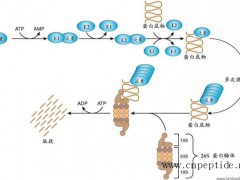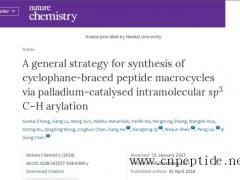
2015年2月10日 讯 /生物谷BIOON/ --中风、心脏病发作以及创伤性脑损伤看似关联性并不大疾病,但其往往存在一些共同的病理学表现,而且最终引发的结果都一样,即细胞死亡,而且患者往往会引发缺氧而引发机体损伤;在这些疾病中缺乏血液供应而受到影响的组织会开启分子信号通路从而停止能量的产生,近日,来自班古里昂大学的研究者在寻找humanin衍生物(humanin是一种神经保护因子)的同时,发现利用细胞中线粒体基因组编码的一种天然多肽可以成功地阻断了上述过程。
研究者Abraham Parola教授表示,当前研究为开发新型药物疗法来治疗坏死相关的疾病,比如创伤性脑损伤、中风及心肌梗死提供了新的希望,而目前并没有有效的疗法来治疗这些疾病。humanin衍生物可以通过中和因坏死引发的ATP水平的降低而发挥作用。文章中,研究者通过利用新发现的天然多肽类治疗暴露坏死因子后的神经元细胞来检测humanin类似物AGA(C8R)-HNG17和AGA-HNG的效率,实验结果显示是有效的。
此前研究中研究者阐明了抗血管生成抑制药物的作用机制及细胞膜的动力学变化,抗血管生成抑制药物可以通过抑制营养物和氧气向快速生长组织供给来促进恶性肿瘤细胞的死亡,而本文研究结果则揭示了心磷脂也参与了上述过程。目前研究人员正在利用HNG17类似物对创伤性脑损伤的小鼠进行体内试验,从而就可以成功减少小鼠颅内液体的积聚并且降低小鼠的神经元严重性分数。
随着研究人员研究的深入,他们发现利用HNG17来进行的药物运输系统或许可以更加有效地治疗患者的疾病,后期研究者将进一步探索肝硬化患者机体发生缺血性活动的机制,以及如何通过醋氨酚来诱导缺血性活动;同时研究者也希望在humanin和其它的抗坏死制剂中寻找一种协同效应,比如蛋白酶抑制药,从而来增加其在临床上的作用。(生物谷Bioon.com)
本文系生物谷原创编译整理,欢迎转载!转载请注明来源并附原文链接。谢谢!
生物谷推荐的新闻阅读:
By employing derivatives of humanin, a naturally occurring peptide encoded in the genome of cellular mitochondria, researchers at Ben Gurion University of the Negev are working to interrupt this process, buying precious time for tissues whose cellular mechanisms have called it quits.
"The present findings could provide a new lead compound for the development of drug therapies for necrosis-related diseases such as traumatic brain injury, stroke and myocardial infarction -- conditions for which no effective drug-based treatments are currently available [that work by blocking necrosis]," said Abraham Parola, a professor of biophysical chemistry at Ben Gurion University of the Negev in Beer-Sheva, Israel. Parola is presently a visiting professor of Biophysical Chemistry & Director of Natural Sciences at New York University Shanghai, and will speak about his lab's finding's this week at the Biophysical Society's 59th annual meeting in Baltimore, Md.
The humanin derivatives work by counteracting the decrease in ATP levels caused by necrosis. The researchers tested the effectiveness of the humanin analogues AGA(C8R)-HNG17 and AGA-HNG by treating neuronal cells with these peptides prior to exposure to a necrotic agent. The experiments were a success.
Parola's previous work has dealt with membrane dynamics and the mechanism of action of anti-angiogenesis drugs, which cause starvation of malignant tumor growths by preventing the supply of nutrients and oxygen to the fast growing tissue, in addition to various other biophysical and molecular medicine and diagnostic topics.
"A recent paper published by our group suggested the involvement of cardiolipin [a phospholipid in inner mitochondrial membranes] in the necrotic process," Parola said. "During this work we stumbled along humanin and were intrigued by its anti-apoptotic effect, and extended it to anti-necrotic effect."......





